



 All payments are encrypted via SSL
All payments are encrypted via SSL
 Full Refund if you haven't received your order
Full Refund if you haven't received your order
Broxinac - eye drops, which are non-steroidal anti-inflammatory agent, which is used in ophthalmology in the postoperative period. The drug reduces the inflammatory process and has an analgesic effect.
Broxinac is produced in the form of eye drops, which are a clear solution of greenish-yellow color.
The main active ingredient of the drug is bromfenac sodium sesquihydrate (0.9 mg / 1 ml solution).
Excipients: boric acid, polysorbate 80, povidone, sodium borate decahydrate, povidone, benzalkonium chloride, anhydrous sodium sulfite, sodium hydroxide, distilled water.
In one bottle is 1.7 ml, each bottle is packed in a cardboard box, in which the instructions for use are enclosed.
The active substance of bromfenac is NSAIDs, which has anti-inflammatory and analgesic properties. The reduction of the inflammatory process and the reduction of pain syndrome is due to inhibition of cyclooxygenase (1 and 2) followed by blockade of prostaglandin synthesis from arachidonic acid.
Clinical studies have proven that prostaglandins belong to mediators of certain types of eye inflammations.
Animal studies have shown that prostaglandins break the hemophthalmological barrier, increase vascular permeability, cause the development of vasodilation, leukocytosis, increase intraocular pressure.
Appointed to patients undergoing eye surgery, including cataract extraction in the postoperative period to reduce the inflammatory process and pain reactions.
Contraindicated in patients with the following conditions:
The drug should be used with caution to people with sensitivity to sulfites: suffering from bronchial asthma or with a history of allergic reactions.
When using Broxinac eye drops, cross-sensitivity to derivatives of phenylacetic acid, acetylsalicylic acid and other nonsteroidal anti-inflammatory drugs may develop. When treating patients with previously identified sensitivity to these agents, care must be taken.
Non-steroidal anti-inflammatory drugs can interfere with platelet aggregation, thereby increasing bleeding time. When using NSAIDs locally on the background of ophthalmologic surgical interventions, an increase in bleeding of eye tissues (including in the anterior chamber) may be observed.
It should be used with caution in patients prone to bleeding, as well as taking other drugs that increase the time of hemocoagulation.
Side effects are most susceptible to patients with complications after surgical ophthalmologic interventions, as well as pathologies such as: denervation of the cornea, defects of the corneal epithelium, diabetes mellitus, superficial eye diseases (including dry eye syndrome), rheumatoid arthritis.
A single use can lead to the development of the following adverse reactions:
Double use of the drug can cause the development of the following reactions:
Overdose cases to date are not registered. In the case of internal use of the drug is recommended to reduce the concentration of the drug in the stomach, after consuming a large amount of fluid.
The simultaneous use of Broxinac with other eye drops: carbonic anhydrase inhibitors, α-adrenomimetics, β-blockers, mydriatics is allowed. The interval between instillations must be at least 5 minutes.
With the local use of nonsteroidal anti-inflammatory drugs the day before the ophthalmologic surgical intervention increases the risk of development and severity of side effects from the cornea.
The use of topical NSAIDs can cause the development of keratitis. With long-term topical use of nonsteroidal anti-inflammatory drugs in susceptible patients, epithelium rupture, thinning of the cornea, thinning of the cornea, erosion of the cornea, formation of the ulcer on the cornea, or its perforation may occur, which creates the risk of loss of vision. Patients with symptoms of epithelial rupture should immediately stop treatment with the drug and consult a doctor.
With the simultaneous use of NSAIDs with topical corticosteroids, wound healing can be slowed down, which patients should be warned about.
Due to the presence of benzalkonium chloride in the formulation, which can provoke the development of local eye irritation, before instillation of Broxinac eye drops, contact lenses must be removed from the eyes and installed back no earlier than 15 minutes after instillation.
In order to preserve the sterility of the solution, it is necessary to avoid touching the tip of the dropper to the surface of the eyes and eyelids.
The drug has little impact on the ability to manage complex mechanisms and driving vehicles. After instillation of the drug, the appearance of short-term blurred vision may occur, therefore, the above described actions should be avoided before the vision is fully restored.
Broxinac eye drops are not used in children and adolescents (under 18).
Due to the lack of data on the safety of using Broxinac eye drops for pregnant women and women during breastfeeding, it is necessary to use the drug for treatment during these periods with caution. In the last trimester of pregnancy, Broxinac is not recommended.
The drug should be stored at a temperature not exceeding 25 degrees Celsius, in a place inaccessible to children. Shelf life is two years.
